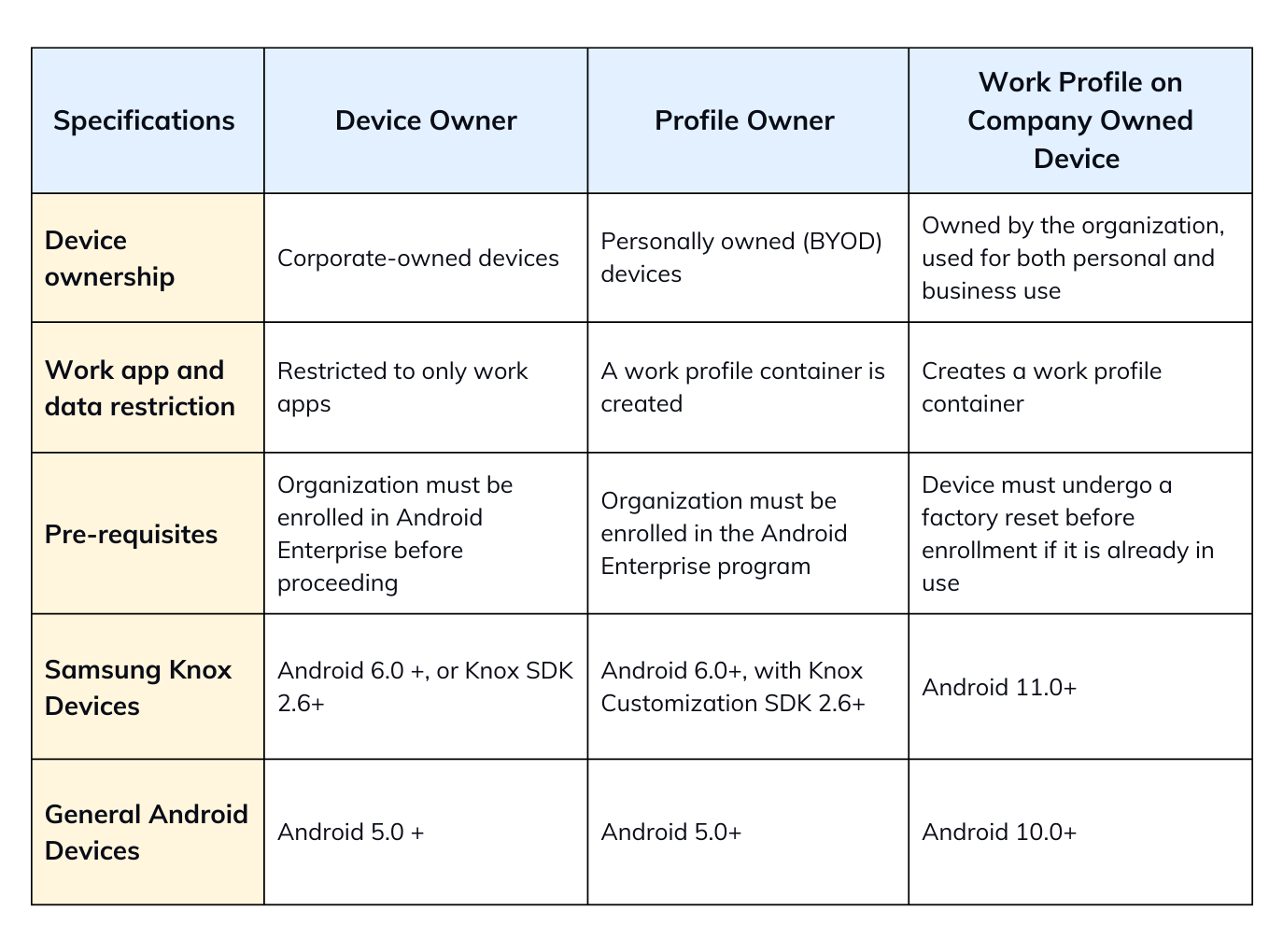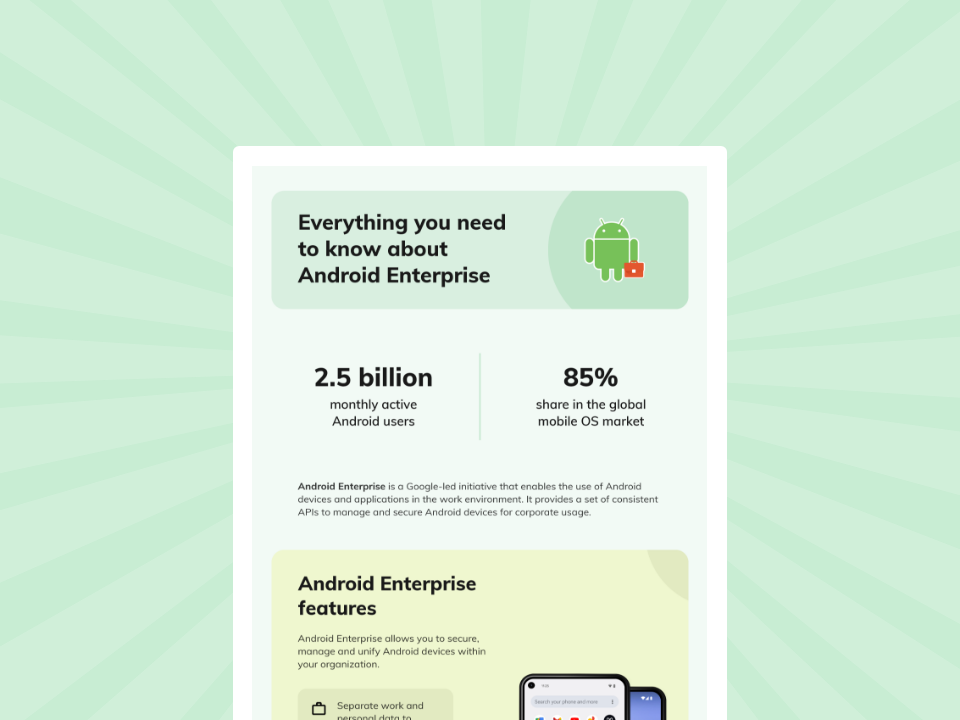Google Android Enterprise: Feature Updates for 2025
Introducing stronger security, identity checks, corporate badge support and smarter management

Get fresh insights, pro tips, and thought starters–only the best of posts for you.
Estella Pocket
Sep 10, 2025
15 min read

Whether you are a large-scale enterprise managing hundreds of devices or a growing new-age company just stepping into the market, the challenges of handling corporate-owned and employee-owned devices (in a BYOD setup) are inevitable. The process of configuring each device with the necessary policies and settings can often feel overwhelming.
This blog provides a comprehensive guide to help you seamlessly onboard your Android devices into an MDM platform, ensuring smooth deployment and efficient management from the start.
Android onboarding is the structured setup process that turns an Android device into a compliant, work-ready unit managed by your IT policies. With Hexnode UEM, onboarding typically includes:
Purpose:
Despite the benefits, organizations still face common challenges when enrolling Android devices.
With automated enrollment methods, IT teams can skip the manual setup, save time and make sure every device is secure and work-ready from the start. There are three methods under this:
Android ZTE is Google’s automated provisioning framework for corporate-owned Android devices. Enables out-of-the-box enrollment into an MDM the moment devices are powered on and connected to the internet.
Advantages
Samsung Knox Mobile Enrollment (KME) is a bulk provisioning service that automates enrollment of Samsung-owned devices into an organization’s MDM. Once powered on and connected to a network, devices automatically download the MDM profile, install necessary configurations, and apply enterprise security policies.
Advantages
Android Enterprise is Google’s official system for managing work devices. It provides enhanced security, centralized app management, and deployment flexibility with enrollment options such as Device Owner, Profile Owner, and Work Profile on Company-Owned Devices (WP-C).
The enrollment process involves three phases:
Device owner enrollment
This mode is used for corporate-owned devices where IT requires complete control over the device. Once enrolled, all personal apps and accounts are removed, and the device is restricted to only work apps and configurations provisioned by the organization.
Pre-requisite: Organization must be enrolled in Android Enterprise before proceeding with Device Owner enrollment.
Device requirements
Samsung Knox devices – Android 6.0 +, or Knox SDK 2.6 and above.
General Android devices – Android 5.0 +
Devices must be factory reset before enrollment. Ensure all accounts are removed prior to reset.
Profile owner enrollment
This is for BYOD devices where both personal and corporate usage must coexist securely. Unlike Device Owner enrollment, devices do not require a factory reset. Instead, a work profile container is created, isolating enterprise apps and data from personal usage. Personal and work apps are available on the same device, with corporate apps marked by a work badge.
Pre-requisite: Organization must be enrolled in the Android Enterprise program.
Device requirements
Samsung Knox (SAFE) devices – Android 6.0+, with Knox Customization SDK 2.6 or above.
General Android devices – Android 5.0+.
Work profile on company-owned devices (WP-C)
Devices on WP-C are owned by the organization but provisioned for both personal and business use. Enrollment creates a dedicated work profile container, isolating corporate apps and data from the user’s personal environment. IT administrators retain control over the work profile while ensuring personal data and applications remain unaffected.
Device Requirements
Samsung Knox Devices – Android 11.0+.
Standard Android Devices – Android 10.0+.
Device must undergo a factory reset before enrollment if it is already in use.

Hexnode UEM offers multiple enrollment methods for Android devices, ensuring flexibility across different enterprise use cases, corporate-owned, BYOD, or large-scale deployments. Enrollment can be carried out with or without authentication, via self-enrollment using enterprise credentials, or through QR code-based provisioning.
Simplifies setup by removing the need for manual entry of the MDM server name or credentials.
Types:
ROM enrollment involves flashing a custom Android firmware where Hexnode UEM is pre-installed as a system or privileged app. Usually used by enterprises working alongside OEM vendors. Once provisioned, devices automatically enrolled in Hexnode UEM when powered on for the first time, requiring no user interaction.
Advantages
Onboarding Android devices in bulk is more than just enrolling the device, it’s a matter of security, consistency, and efficiency from the very first boot. Hexnode simplifies this process with a set of actions designed to simplify deployment, secure corporate data, and reduce IT work.
Hexnode provides a single unified console to enroll, configure, monitor, and secure Android devices along with other platforms. Dashboards, reports on compliance status, and automated alerts enable IT teams to have complete visibility.
Hexnode leverages Android Zero-Touch Enrollment (ZTE), Samsung Knox Mobile Enrollment (KME) to enable automatic provisioning. Users simply power on the device, connect to a network, and corporate configurations are applied in real-time.
Predefined enrollment profiles and dynamic device groups allow policies to be auto-applied based on factors such as device type, OS version, or ownership mode. These policies include:
This ensures consistency across large-scale deployments and reduces IT work.
Security controls are applied immediately during enrollment, preventing non-compliant devices from entering the corporate environment. This includes password enforcement, encryption, app allow/blocklisting, and MDM removal prevention. Remote wipe and lock capabilities are available in case of loss or theft.
Hexnode minimizes trouble for end users by:
For industries such as retail, healthcare, or education, Hexnode supports kiosk mode, restricting devices to single or multiple apps, or web-app kiosk. Hardware buttons and system UI can be disabled to ensure devices remain dedicated to business functions.
To validate policies and ensure smooth deployment, organizations can run pilot tests with a small group of devices. This confirms enrollment success, required app installations, and remote management functions before scaling organisation-wide.

Discover how to secure your devices, make it efficient and work-ready with Android Enterprise. Learn the evolution and benefits of the program by downloading the infographic.
DownloadThe most common onboarding challenges organizations face when onboarding Android:
Challenge: Devices fail to provision automatically even when powered on.
Cause:
Device may not be registered or lacks a configuration assignment in the Zero‑Touch portal.
Fix:
Challenge: Hexnode agent fails to install or operates with broken features.
Cause:
Runtime permission model in Android 6.0+ may restrict certain permissions like notifications, even if pre‑granted.
Fix:
Challenge: Devices get stuck or fail during work profile creation.
Cause and fix:
Existing residual profiles on the device can block setup – Remove any old work profiles and factory‑reset the device.
Challenge: Managed apps won’t install or policies fail to apply.
Cause and fix:
Challenge: Admin encounters errors like ‘Cannot enroll organization’ or ‘Organization enrollment failed.’
Cause and fix:
Hexnode is highly adaptable across industries, as organizations can select the appropriate enrollment model and policy set depending on device ownership, compliance needs, and user workflows. Below are the most common enterprise scenarios where Hexnode’s Android management delivers value.
Use Case: Enterprises often distribute fully managed, company-owned devices to employees for business-critical operations.
How Hexnode Helps:
Value: Ensures compliance and security at scale, ideal for industries with sensitive data handling such as finance, logistics, and professional services.
Use Case: In schools and universities when shared tablets or student-assigned devices are used for digital learning, testing, and research.
How Hexnode Helps:
Value: Promotes secure digital learning environments, reduces device misuse, and simplifies IT management in resource-constrained educational institutions.
Use Case: In hospitals and clinics using Android tablets or kiosk mode for patient check-in, medical record access, or online consultations.
How Hexnode Helps:
Value: Provides secure, compliant devices while reducing IT work in highly regulated healthcare environments.
Use Case: When employees prefer to use their personal devices for work, it requires enterprises to balance productivity with privacy.
How Hexnode Helps:
Value: Delivers a privacy-first BYOD strategy that encourages employee adoption while maintaining enterprise data protection.
1. What is Android Zero-Touch Enrollment?
Android Zero-Touch Enrollment is a Google program that allows organizations to enroll Android devices without manual intervention. When the device is powered on, it auto-enrolls into Hexnode UEM and applies assigned policies.
2. Can I enroll personal Android devices (BYOD)?
Yes. Personal devices can be brought under management and be enrolled with Android Enterprise work pofile enrollment. Hexnode creates a secure, containerized work profile on the device, keeping business apps and data separate from the user’s personal apps and content.
3. Do I need a Knox or Zero-Touch portal to enroll?
Knox Mobile Enrollment for Samsung and Google Zero-Touch Enrollment are recommended for large corporate or institution-owned fleets to enable seamless onboarding. However, for smaller rollouts or BYOD scenarios, QR code, email enrollment into Hexnode performs well.
4. What permissions are needed during manual enrollment?
These permissions are crucial for enabling Hexnode to configure apps, enforce security, and maintain compliance controls:
5. How can I prevent users from removing MDM/UEM profiles?
Depending on ownership type, here’s how you can achieve it:
In an era where efficiency defines success, Hexnode ensures that Android onboarding is not just a process, but a strategic advantage. By making deployment seamless, scalable, and secure, Hexnode empowers organizations to focus on growth rather than technical hurdles. The right onboarding solution doesn’t just set up devices, it sets the stage for long-term success.
How soon are you ready to experience the difference with Hexnode?
Ready to experience the difference with Hexnode? Start your 14-day free trial now.
Signup now